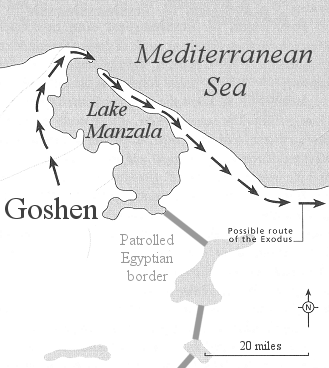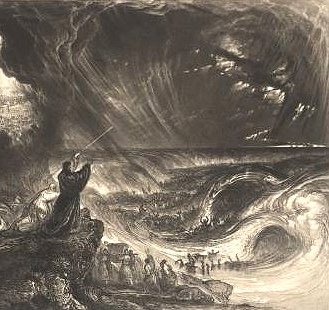Act of God
According to the book of Exodus, the Israelites began their trek out of Egypt once the plagues had persuaded the pharaoh to set them free. However, before long the pharaoh had a change of heart and ordered his army to pursue them. With their backs to the Red Sea all seemed lost until God again interceded and caused the waters to part. The Israelites were so able to walk across the seabed, but when the Egyptian army tried to follow the waters returned and they were washed away.
Moses parts the sea. Illustration by the English artist John Martin made in 1833.

It is possible that this was another Exodus event also caused by the Thera eruption. The Thera volcano was on the island of Santorini and geological surveys have shown that the massive eruption caused a large part of the island to collapse into the sea, creating a series of gigantic tsunami or tidal waves that might explain the Old Testament account.
Route of the Exodus from Goshen, avoiding the patrolled Egyptian border with the wilderness.
Page 2 of 2
The Parting of the Red Sea
Firstly, it seems that the event did not happen at the Red Sea to the east of Egypt but at another stretch of water in the northeast Nile Delta. It is now recognized that the name Red Sea is actually a mistranslation. The original Hebrew Bible describes the place where the Israelites crossed out of Egypt as Yam Suph – “The Reed Sea”. This was the old name for Lake Manzala on the Mediterranean coast at the extreme northeast of Egypt. Its modern name is somewhat misleading as it is actually open to the sea. However, this was not always the case. In ancient times, when sea levels were lower, it was divided from the Mediterranean by a narrow ridge of dry land some 30 miles long, broken by a short stretch of water at high tide. At low tide this became a causeway that could be crossed on foot.
This is a route that makes sense. The Bible tells us that the Israelites were enslaved in an area called Goshen in the north-east of Egypt, and the best way to escape Egypt from here, avoiding the patrolled border, would have been to head north and then cross the Manzala causeway at low tide. If a tsunami had hit the coast when the Egyptians were following the result would have been very much as the Bible describes.
Preceding the arrival of a tsunami the coastal sea level often drops. (It is basically the same phenomenon that causes the sea to withdraw before the breaking of a normal wave, only over a longer duration). Such a phenomenon may have worked to the Israelites’ advantage. If a section of the Manzala causeway usually under water had been exposed by the pre-tsunami conditions, then the Israelites could have crossed in the way the Bible relates: "and the waters were divided" (Exodus 14:21). This is an excellent description of what could have happened at the Manzala causeway, with the waters of the Mediterranean having divided from the waters of the Lake Manzala. The Israelites could have made it safely across and, if the timing was right, the pursuing soldiers might have been attempting to follow when the tsunami hit.
And the waters returned and covered the chariots, and the horsemen and all the host of Pharaoh that came into the sea after them; there remained not so much as one of them. (Exodus 14:29.)
The dreadful tragedy in South Asia on 26 December 2004, where an earthquake off the west coast of northern Sumatra caused waves as high as twenty feet to crash into coastal areas of Sri Lanka and India, over six hundred miles away, shows both how devastating and far reaching the destructive power of tsunami can be. Geologists have estimated the magnitude of the similar tsunami caused by the Thera eruption: huge waves, well over twenty feet high, would easily have reached the Egyptian coast which was only a little over four hundred miles away.
Pharaoh’s Army engulfed by The Red Sea, painted in 1900 by the American artist Frederick Arthur Bridgman. Could this have been an historical event caused by a massive tsunami?

"Of the many books out recently shedding new light on ancient history, this attempt to prove that the Bible is nearer historical truth than skeptics maintain is one of the best"
Daily Mail
"A wealth of detail about strange behavior in the Valley of the Kings"
Sunday Times
"Graham Phillips’s real contribution to what might be called the world of alternative ancient history is his connection of the natural disasters and phenomena described in Exodus with the eruption of Thera... plausibly argued"
Times Literary Supplement
"Attractive and plausible theory"
Catholic Herald
UK and Commonwealth editions: HB Sidgwick & Jackson 1998, PB Pan 1998.
US Edition: The US edition of Act of God is published by Bear & Company (2003) under the title Atlantis and the Ten Plagues of Egypt.
Translations: Heyne (German), Sperling & Kupfer (Italian), Bertrand Editora Lda (Portuguese), Tirion (Dutch), Asahi Shimbun (Japanese), Trivium Konyvkiado (Hungarian), Rebis (Polish).
Click on image to order the US edition.











